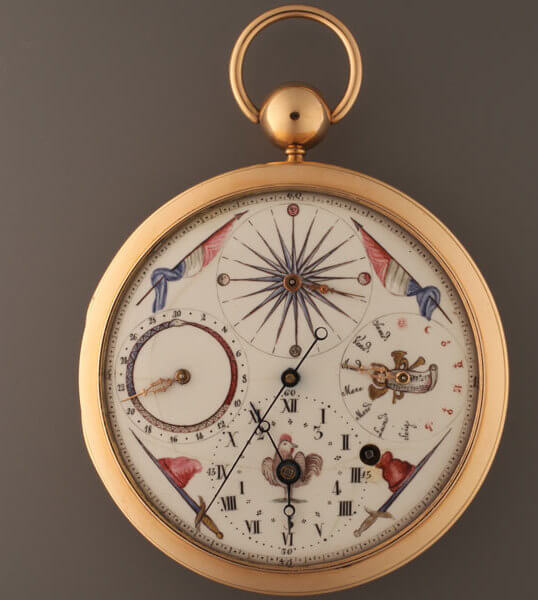In its endeavour to break with the past and embrace a truly “revolutionary” future, the Convention Nationale (France’s new government which founded the First Republic in 1792) turned its attention to the arts and sciences. As part of this new beginning, it proposed the introduction of unified systems for weights, measures and the calculation of time based on the decimal system. After the Republican calendar – which divided the year into 12 months of 30 days plus five feast days, the Sansculottides, in an ordinary year (four ordinary years equalling one Franciade) and six in a leap year -, decimal time came into force on the Quartidi Frimaire of Year II (November 24th, 1793). Out went the ounce, the quartern and the quintal. It was curtains for the foot, the toise and the acre. The bushel, the muid, the demiard and the pint were no more. Similarly, the day was now divided into ten hours, each lasting 100 minutes with a further division of one minute into 100 seconds. The sexagesimal system inherited from the Babylonians had done its time (literally!).
A spanner in the works
Members of the Convention could point to some solid precedents, such as Ancient Egypt or China, both of which had opted for a decimal time system. They also had the overwhelming support of the scientific community. Even so, this “revolutionary” time threw a spanner in the works. Adapting the tower clocks that still put the lives of many rural communities in order was impossible at first. Adapting the watches already in circulation proved to be an equally thorny problem, given the mammoth task of adjusting components by hand. As for the new mechanisms developed by the leading lights of the day – the likes of Abraham-Louis Breguet, Antide Janvier, Pierre-Basile Lepaute and Louis Berthoud – they were the preserve of a wealthy few. Dials that displayed both the old and new systems became a means of simplifying day-to-day life for everyone but the watchmakers producing them, who had to account for the fact that one “revolutionary” hour was equal to 2 hours and 24 minutes under the sexagesimal system.
Subdivisions of the second
The ensuing confusion, added to the difficulties raised by this sudden insularity, finally got the better of decimal time. In April 1795 the Convention passed a law that suspended its use. The Republican calendar fared little better, as it was abolished by Napoleon Bonaparte in 1806. Almost a century went by before international scientific conferences put decimal time back on the table. Unsuccessfully, as it turned out, given the “revolution” such a sea change implied. Ultimately, the metric system prevailed only for the subdivisions of the second, initially in response to the greater precision required by competitive sport. Remnants of decimal time were also found in factories, where shifts were occasionally calculated to the nearest 1/100th of an hour. Closer to home, in 1998 the Swatch Group launched Internet Time (still shown on its website) which divides time into 1,000 beats a day. If you finish reading this article at 2.05pm, that’s @545 beats! So what time did you say it was?












